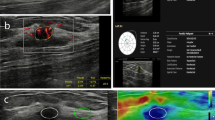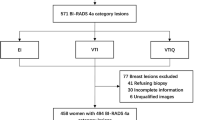Abstract
Objectives
To compare the diagnostic efficacies of B-mode ultrasound (US), strain elastography (SE), contrast-enhanced ultrasound (CEUS) and the combination of these modalities for breast lesions <1 cm in size.
Methods
Between January 2013 and October 2015, 203 inpatients with 209 sub-centimetre breast lesions categorised as BI-RADS-US (Breast Imaging Reporting and Data System for Ultrasound) 3-5 were included. US, SE and CEUS were performed to evaluate each lesion. The diagnostic performances of different ultrasonic modalities were compared. The diagnostic efficacies of BI-RADS-US and our re-rating systems were also compared. The pathology findings were used as the reference standard.
Results
The specificities of US, SE and CEUS for tumour differentiation were 17.4 %, 56.2 % and 86.0 %, respectively (P < 0.05); and the sensitivities were 100 %, 93.2 % and 93.2 % for US, SE and CEUS, respectively (P < 0.05). The area under the curve (AUC) of the receiver operating characteristic (ROC) curve was 0.867 for original BI-RADS-US, 0.882 for BI-RADS-US combined with only SE, 0.953 for BI-RADS-US combined with only CEUS and 0.924 for BI-RADS-US combined with both SE and CEUS. The best combination was BI-RADS-US combined with only CEUS.
Conclusions
Evaluating sub-centimetre breast lesions with SE and CEUS could increase the diagnostic specificity while retaining high sensitivity compared with B-mode ultrasound.
Key Points
• Evaluating breast lesions with SE and CEUS could increase the diagnostic specificity
• SE and CEUS offer alternatives to biopsy and possibly allow shorter-interval follow-ups
• BI-RADS-US combined with CEUS exhibited the best diagnostic performance




Similar content being viewed by others
Abbreviations
- US:
-
B-mode ultrasound
- SE:
-
Strain elastography
- CEUS:
-
Contrast-enhanced ultrasound
- BI-RADS-US:
-
Breast Imaging Reporting and Data system for Ultrasound
References
Ellis I (2008) Prognosis of small screen-detected invasive breast cancers. Breast Cancer Res 10:P1
Tabar L, Yen MF, Vitak B et al (2003) Mammography service screening and mortality in breast cancer patients: 20-year follow-up before and after introduction of screening. Lancet 361:1405–1410
Tabar L, Chen HH, Duffy SW et al (2000) A novel method for prediction of long-term outcome of women with T1a, T1b, and 10-14 mm invasive breast cancers: a prospective study. Lancet 355:429–433
Tabar L, Tony CH, Amy YM et al (2004) Mammographic tumor features can predict long-term outcomes reliably in women with 1-14-mm invasive breast carcinoma. Cancer 101:1745–1759
Mainiero MB, Lourenco A, Mahoney MC et al (2013) ACR appropriateness criteria breast cancer screening. J Am Coll Radiol 10:11–14
Freer PE (2015) Mammographic breast density: impact on breast cancer risk and implications for screening. Radiographics 35:302–315
Lee JH, Kim SH, Kang BJ et al (2011) Role and clinical usefulness of elastography in small breast masses. Acad Radiol 18:74–80
Sadigh G, Carlos RC, Neal CH et al (2012) Ultrasonographic differentiation of malignant from benign breast lesions: a meta-analytic comparison of elasticity and BIRADS scoring. Breast Cancer Res Treat 133:23–35
Garra BS (2007) Imaging and estimation of tissue elasticity by ultrasound. Ultrasound Q 23:255–268
Hatzung G, Grunwald S, Zygmunt M et al (2010) Sonoelastography in the diagnosis of malignant and benign breast lesions: initial clinical experiences. Ultraschall Med 31:596–603
Itoh A, Ueno E, Tohno E et al (2006) Breast disease: clinical application of US elastography for diagnosis. Radiology 239:341–350
Wells PN, Liang HD (2011) Medical ultrasound: imaging of soft tissue strain and elasticity. J R Soc Interface 8:1521–1549
Wojcinski S, Farrokh A, Weber S et al (2010) Multicenter study of ultrasound real-time tissue elastography in 779 cases for the assessment of breast lesions: improved diagnostic performance by combining the BI-RADS(R)-US classification system with sonoelastography. Ultraschall Med 31:484–491
Sadigh G, Carlos RC, Neal CH et al (2012) Accuracy of quantitative ultrasound elastography for differentiation of malignant and benign breast abnormalities: a meta-analysis. Breast Cancer Res Treat 134:923–931
Wan C, Du J, Fang H et al (2012) Evaluation of breast lesions by contrast enhanced ultrasound: qualitative and quantitative analysis. Eur J Radiol 81:e444–e450
Caproni N, Marchisio F, Pecchi A et al (2010) Contrast-enhanced ultrasound in the characterisation of breast masses: utility of quantitative analysis in comparison with MRI. Eur Radiol 20:1384–1395
Hu Q, Wang XY, Zhu SY et al (2015) Meta-analysis of contrast-enhanced ultrasound for the differentiation of benign and malignant breast lesions. Acta Radiol 56:25–33
Liu H, Jiang Y, Dai Q et al (2015) Differentiation of benign and malignant sub-1-cm breast lesions using contrast-enhanced sonography. J Ultrasound Med 34:117–123
Zhi H, Ou B, Xiao XY et al (2013) Ultrasound elastography of breast lesions in chinese women: a multicenter study in China. Clin Breast Cancer 13:392–400
Liu H, Jiang YX, Liu JB et al (2008) Evaluation of breast lesions with contrast-enhanced ultrasound using the microvascular imaging technique: initial observations. Breast 17:532–539
Jiang YX, Liu H, Liu JB et al (2007) Breast tumor size assessment: comparison of conventional ultrasound and contrast-enhanced ultrasound. Ultrasound Med Biol 33:1873–1881
Du J, Li FH, Fang H et al (2008) Correlation of real-time gray scale contrast-enhanced ultrasonography with microvessel density and vascular endothelial growth factor expression for assessment of angiogenesis in breast lesions. J Ultrasound Med 27:821–831
Xiao X, Ou B, Yang H et al (2014) Breast contrast-enhanced ultrasound: is a scoring system feasible? A preliminary study in China. PLoS One 9:e105517
Thomas A, Fischer T, Frey H et al (2006) Real-time elastography—an advanced method of ultrasound: first results in 108 patients with breast lesions. Ultrasound Obstet Gynecol 28:335–340
Moon WK, Im JG, Noh DY et al (2000) Nonpalpable breast lesions: evaluation with power Doppler US and a microbubble contrast agent-initial experience. Radiology 217:240–246
Balleyguier C, Opolon P, Mathieu MC et al (2009) New potential and applications of contrast-enhanced ultrasound of the breast: Own investigations and review of the literature. Eur J Radiol 69:14–23
Zhi H, Xiao XY, Ou B et al (2012) Could ultrasonic elastography help the diagnosis of small (≤2 cm) breast cancer with the usage of sonographic BI-RADS classification? Eur J Radiol 81:3216–3221
Giuseppetti GM, Martegani A, Di Cioccio B et al (2005) Elastosonography in the diagnosis of the nodular breast lesions: preliminary report. Radiol Med 110:69–76
Vinnicombe SJ, Whelehan P, Thomson K et al (2014) What are the characteristics of breast cancers misclassified as benign by quantitative ultrasound shear wave elastography? Eur Radiol 24:921–926
Raza S, Odulate A, Ong EM et al (2010) Using real-time tissue elastography for breast lesion evaluation: our initial experience. J Ultrasound Med 29:551–563
Ciurea AI, Bolboaca SD, Ciortea CA et al (2011) The influence of technical factors on sonoelastographic assessment of solid breast nodules. Ultraschall Med 32:S27–S34
Weidner N, Semple JP, Welch WR et al (1991) Tumor angiogenesis and metastasis—correlation in invasive breast carcinoma. N Engl J Med 324:1–8
Acknowledgments
The scientific guarantor of this publication is Baoming Luo. The authors of this manuscript declare no relationships with any companies, whose products or services may be related to the subject matter of the article.
The authors state that this work has not received any funding. No complex statistical methods were necessary for this paper. Institutional Review Board approval was obtained. Written informed consent was waived by the Institutional Review Board. No study subjects or cohorts have been previously reported. Methodology: retrospective, diagnostic or prognostic study, performed at one institution.
Author information
Authors and Affiliations
Corresponding author
Rights and permissions
About this article
Cite this article
Xiao, X., Jiang, Q., Wu, H. et al. Diagnosis of sub-centimetre breast lesions: combining BI-RADS-US with strain elastography and contrast-enhanced ultrasound—a preliminary study in China. Eur Radiol 27, 2443–2450 (2017). https://doi.org/10.1007/s00330-016-4628-4
Received:
Revised:
Accepted:
Published:
Issue Date:
DOI: https://doi.org/10.1007/s00330-016-4628-4




